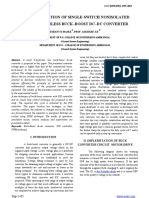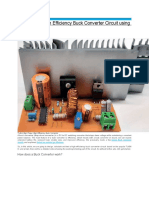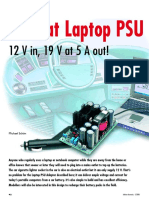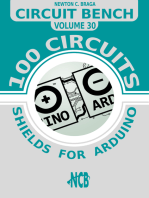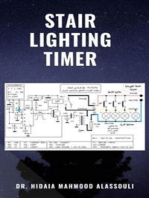0 ratings0% found this document useful (0 votes)
12 viewsDiy Boost Calc
Diy Boost Calc
Uploaded by
kutu32This document provides instructions and a calculator for designing a DIY DC/DC boost converter. It explains how boost converters work and the components needed, including an inductor, capacitor, diode, and switch. Users input specifications like voltage ranges and current, and the calculator outputs the required duty cycle, inductor size, peak current, and minimum capacitor for the design.
Copyright:
© All Rights Reserved
Available Formats
Download as PDF, TXT or read online from Scribd
Diy Boost Calc
Diy Boost Calc
Uploaded by
kutu320 ratings0% found this document useful (0 votes)
12 views6 pagesThis document provides instructions and a calculator for designing a DIY DC/DC boost converter. It explains how boost converters work and the components needed, including an inductor, capacitor, diode, and switch. Users input specifications like voltage ranges and current, and the calculator outputs the required duty cycle, inductor size, peak current, and minimum capacitor for the design.
Original Description:
calculation for boost converter
Copyright
© © All Rights Reserved
Available Formats
PDF, TXT or read online from Scribd
Share this document
Did you find this document useful?
Is this content inappropriate?
This document provides instructions and a calculator for designing a DIY DC/DC boost converter. It explains how boost converters work and the components needed, including an inductor, capacitor, diode, and switch. Users input specifications like voltage ranges and current, and the calculator outputs the required duty cycle, inductor size, peak current, and minimum capacitor for the design.
Copyright:
© All Rights Reserved
Available Formats
Download as PDF, TXT or read online from Scribd
Download as pdf or txt
0 ratings0% found this document useful (0 votes)
12 views6 pagesDiy Boost Calc
Diy Boost Calc
Uploaded by
kutu32This document provides instructions and a calculator for designing a DIY DC/DC boost converter. It explains how boost converters work and the components needed, including an inductor, capacitor, diode, and switch. Users input specifications like voltage ranges and current, and the calculator outputs the required duty cycle, inductor size, peak current, and minimum capacitor for the design.
Copyright:
© All Rights Reserved
Available Formats
Download as PDF, TXT or read online from Scribd
Download as pdf or txt
You are on page 1of 6
DIY DC/DC Boost Calculator
Created by Tyler Cooper
Last updated on 2013-06-16 08:30:27 PM EDT
2
3
5
Guide Contents
Guide Contents
Overview
The Calculator
Adafruit Industries http://learn.adafruit.com/diy-boost-calc Page 2 of 6
Overview
For many small projects, its cheaper and easier to DIY a boost converter than to buy a specialty
chip. DIY converters are usually not as efficient but they're quick & cheap!
The above schematic section shows how I designed a 30-60V vacuum fluorescent tube display
driven from a microcontroller pin.
Tubes such as VFDs, Nixies, Decatrons, etc require high voltage to light the gas in the tube. In
order to reduce cost, we use a microconrtoller to make a boost converter and avoid paying $5
for a seperate chip. We can do this because we don't need a precision output and the current
draw is mostly constant. The boost regulator is run open-loop there is no feedback resistor
divider as it isn't necessary as long as the input voltage is within a reasonable range
The microcontroller runs at 8MHz so the 8-bit PWM output is 31250 Hz. The inductor and output
capacitor is calculated below. The diode is a standard Schottkey type, but make sure you
specify one that can handle the full voltage difference and peak current. The switch just has to
be able to handle the max voltage plus some for safety. Note that this design is meant for
'static' output currents, not for variable current draw designs. There is no feedback and its very
approximate! This is not for precision electronics!
The boost circuit works by connecting the power inductor L1 to ground that current can flow
through it by turning on Q2. After a little bit of time, we disconnect the inductor from ground (by
turning off Q2) this means that there is no longer a path for the current in L1 to flow to ground.
When this happens, the voltage across the inductor increases (this is the electric property of
inductors) and charges up C6 . When the voltage increases to the level we want it to be (30V+)
we turn on Q2 again which allows the current in L1 to flow back to ground. If we do this fast
enough, and C6 large enough, the voltage on C6 is smoothed out and we get a nice steady
high voltage
The timing of turning off/on Q2 allows us to modify the output voltage. Normally there is a
feedback resistor to the microcontroller but it is not here because we are running it open-loop.
To drive Q2 we use the PWM output from the microcontroller and adjust the duty cycle to vary
Adafruit Industries http://learn.adafruit.com/diy-boost-calc Page 3 of 6
brightness.
These sorts of designs can be easily made with a 555, once you have the PWM output, connect
it up to Q2!
Adafruit Industries http://learn.adafruit.com/diy-boost-calc Page 4 of 6
The Calculator
For this simple calculator, enter in the freqency, voltage ranges and current ranges and the duty
cycle, inductor and current requirements will be displayed!
Frequency
31250
Hz
This is the boost
converter frequency.
For microcontrollers its
often the CPU clock /
256
Min Vin
9
V
The lowest expected
input voltage
Max Vin
12
V
The highest expected
input voltage
Min Vout
30
V
The lowest desired
output voltage
Max Vout
60
V
The highest desired
output voltage
Iout
0.020
Amps
Output current draw
Vripple
0.1
V
Maximum allowable
voltage ripple
Calculate!
Min. Duty
Cycle
Dmin = 1 - (Vimax/Vomin)
%
Max. duty
cycle
Dmax = 1 - (Vimin/Vomax)
%
Min. Inductor
size
L > D * Vin * (1-D) / (freq * 2 *
Iout )
Adafruit Industries http://learn.adafruit.com/diy-boost-calc Page 5 of 6
size Iout )
uH
Peak inductor
current
Ipk = (Vinmax * D)/(f * L)
A
Minimum
capacitor
Cap > Iout / (Vripple * freq)
uF
Minimum
Schottky
diode
Vbreakdown >= Voutmax & Idiode
>=Ipk
V
A
Adafruit Industries Last Updated: 2013-06-16 08:30:29 PM EDT Page 6 of 6
You might also like
- Temperature Monitoring System FinalDocument49 pagesTemperature Monitoring System Finals_srireddy78% (9)
- 3 Best Transformerless Inverters With Circuit DiagramsDocument35 pages3 Best Transformerless Inverters With Circuit Diagramswinkyi100% (1)
- Switched Mode Power Supply: Major Project ReportDocument26 pagesSwitched Mode Power Supply: Major Project Reportpragatimalviya9876No ratings yet
- Automatic Voltage Stabilizer With PIC16F873ADocument21 pagesAutomatic Voltage Stabilizer With PIC16F873Atahmidmc92% (25)
- Diy Boost CalcDocument4 pagesDiy Boost CalcMomcilo DakovicNo ratings yet
- 0-30 VDC Stabilized Power Supply With CurrentDocument8 pages0-30 VDC Stabilized Power Supply With CurrentDavid ReyesNo ratings yet
- AcknowledgementDocument16 pagesAcknowledgementSourav MahariNo ratings yet
- 0-30 VDC Stabilized Power Supply With Current Control 0.002-3 ADocument12 pages0-30 VDC Stabilized Power Supply With Current Control 0.002-3 Anmgaby21No ratings yet
- Diy Boost CalcDocument4 pagesDiy Boost CalcThatchanaNo ratings yet
- Microchip CLC DescriptionDocument12 pagesMicrochip CLC DescriptionKamlesh YadavNo ratings yet
- A Implementation of Single-Switch Nonisolated Transformerless Buck-Boost DC-DC ConverterDocument6 pagesA Implementation of Single-Switch Nonisolated Transformerless Buck-Boost DC-DC ConverterKPCYP COHODNo ratings yet
- Electronics Projects - DC Motor Speed Control Using H-Bridge - EngineersGarageDocument1 pageElectronics Projects - DC Motor Speed Control Using H-Bridge - EngineersGarageMmeli NtwanaYebhoza DubeNo ratings yet
- High Power High Efficiency Buck Converter Circuit Using TL494Document15 pagesHigh Power High Efficiency Buck Converter Circuit Using TL494Koushik Maity100% (1)
- TheftDocument12 pagesTheftEmeka Nelson OffornedoNo ratings yet
- How To Make A Simple DC To DC Cell Phone Charger CircuitDocument31 pagesHow To Make A Simple DC To DC Cell Phone Charger CircuitShibu Kumar SNo ratings yet
- UnilabDocument5 pagesUnilabshoker4No ratings yet
- Temperature Controlled Fan ReportDocument26 pagesTemperature Controlled Fan ReportHemant Shah43% (7)
- Topswitch Desgin NoteDocument2 pagesTopswitch Desgin NotegubiliNo ratings yet
- UntitledDocument2 pagesUntitledfrank jengoNo ratings yet
- And8142 DDocument10 pagesAnd8142 DJonatan LunaNo ratings yet
- 95-Wat Laptop PSU 12V in - 19V 5A Out PDFDocument7 pages95-Wat Laptop PSU 12V in - 19V 5A Out PDFArina ScăunașuNo ratings yet
- GSM Based Controling of Agriculture MotorDocument69 pagesGSM Based Controling of Agriculture MotorSaieesh somaNo ratings yet
- Electronics Circuit Design LabDocument34 pagesElectronics Circuit Design Labsrvdhar100% (1)
- DC To DC Converter Circuits Using SG3524 (Buck, Boost Designs)Document5 pagesDC To DC Converter Circuits Using SG3524 (Buck, Boost Designs)Branislav TanevskiNo ratings yet
- Ic Based Buck ManualDocument12 pagesIc Based Buck ManualShankar ArunmozhiNo ratings yet
- Power Supplies TutorialDocument9 pagesPower Supplies TutorialBarry Bj ShaideNo ratings yet
- 220V DC To 220V AC: DIY Inverter Part 2: InstructablesDocument10 pages220V DC To 220V AC: DIY Inverter Part 2: InstructablesTnT ElektricNo ratings yet
- Review of DC To DC Buck Converter Based On LM2596Document9 pagesReview of DC To DC Buck Converter Based On LM2596Kshitij MundraNo ratings yet
- Arduino Power Inverter CircuitsDocument8 pagesArduino Power Inverter CircuitsjuliocastNo ratings yet
- Sepic Converter Design and Operation: by Gregory SharpDocument21 pagesSepic Converter Design and Operation: by Gregory SharpSingam SridharNo ratings yet
- Modified Motor PDFDocument11 pagesModified Motor PDFMD. SHAEKH ZAHAB CHOWDHURYNo ratings yet
- 3.1 Block Diagram & Components Description:: Fig: 3.1 Block Diagram of Cyclo-Converter Using MicrocontrollerDocument10 pages3.1 Block Diagram & Components Description:: Fig: 3.1 Block Diagram of Cyclo-Converter Using MicrocontrollerSwamyNo ratings yet
- Embedded SystemDocument16 pagesEmbedded Systemdasarajubhavani05No ratings yet
- How To Use DC To DC Buck Converter LM2596Document6 pagesHow To Use DC To DC Buck Converter LM2596VanBelkumWNo ratings yet
- Speed Control of DC Motor Using PWMDocument6 pagesSpeed Control of DC Motor Using PWMAvinash Dhanuka100% (1)
- 12-24VDC To 3phases AC InverterDocument14 pages12-24VDC To 3phases AC InverterHari YantoNo ratings yet
- Fonte RegulavelDocument19 pagesFonte RegulavelAlex FernandesNo ratings yet
- And8023 DDocument24 pagesAnd8023 Dcititorul53No ratings yet
- 4 Simple Uninterruptible Power SupplyDocument18 pages4 Simple Uninterruptible Power SupplynappaelectronicsNo ratings yet
- 3 High Power SG3525 Pure Sinewave Inverter Circuits - Homemade Circuit ProjectsDocument13 pages3 High Power SG3525 Pure Sinewave Inverter Circuits - Homemade Circuit ProjectsnccgpmduNo ratings yet
- Power ElectronicsDocument2 pagesPower ElectronicsnomNo ratings yet
- 004 Pwm-OcxiDocument7 pages004 Pwm-OcxiNeodymeNo ratings yet
- Study and Design, Simulation of PWM Based Buck Converter For Low Power ApplicationDocument17 pagesStudy and Design, Simulation of PWM Based Buck Converter For Low Power ApplicationIOSRjournalNo ratings yet
- Slot Tech MagazineDocument24 pagesSlot Tech Magazine- M I L T O N - - G. -A100% (1)
- Oscillator: How To Build An InverterDocument7 pagesOscillator: How To Build An InverterGopal Prasad BansalNo ratings yet
- Basic Interview Questions About Power ElectronicsDocument21 pagesBasic Interview Questions About Power Electronicsrekha krishnanNo ratings yet
- ReportDocument15 pagesReportGavaine MattisonNo ratings yet
- Design High Gain DC-DC Boost Converter With Coupling Inductor and Simulation in PsimDocument8 pagesDesign High Gain DC-DC Boost Converter With Coupling Inductor and Simulation in PsimInternational Journal of Research in Engineering and TechnologyNo ratings yet
- Physics Investigatory ProjectDocument20 pagesPhysics Investigatory ProjectarunatchalamNo ratings yet
- AC Voltage Measurement Using PIC16F877A MicrocontrollerDocument15 pagesAC Voltage Measurement Using PIC16F877A Microcontrollervallery1No ratings yet
- Direct Digital Synthesis Controlled Pure Sine Wave InverterDocument17 pagesDirect Digital Synthesis Controlled Pure Sine Wave InverterNabil MohammadNo ratings yet
- Transformer Protection SystemDocument57 pagesTransformer Protection SystemAnkit RajNo ratings yet
- 75 Model Railway ProjectsDocument27 pages75 Model Railway ProjectsMaya DayaNo ratings yet
- New Open Document TextDocument12 pagesNew Open Document TextOpris CosminNo ratings yet
- Google Voice & Internet Based Robotic Water Sprinkler SystemDocument52 pagesGoogle Voice & Internet Based Robotic Water Sprinkler SystemMoozoNo ratings yet
- Reference Guide To Useful Electronic Circuits And Circuit Design Techniques - Part 1From EverandReference Guide To Useful Electronic Circuits And Circuit Design Techniques - Part 1Rating: 2.5 out of 5 stars2.5/5 (3)
- Reference Guide To Useful Electronic Circuits And Circuit Design Techniques - Part 2From EverandReference Guide To Useful Electronic Circuits And Circuit Design Techniques - Part 2No ratings yet
- Gholami 2012-CICIS'12 ProceedingDocument620 pagesGholami 2012-CICIS'12 Proceedingkutu32No ratings yet
- Test LCD TFTDocument3 pagesTest LCD TFTkutu32No ratings yet
- Programming The 8086 8088Document336 pagesProgramming The 8086 8088kutu32100% (2)
- Lecture11 BJT TransistorDocument17 pagesLecture11 BJT Transistorkutu32No ratings yet










